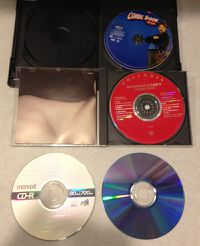Optical Discs
From Just Solve the File Format Problem
(Difference between revisions)
Dan Tobias (Talk | contribs) (→Links) |
Dan Tobias (Talk | contribs) |
||
| Line 30: | Line 30: | ||
** [[China Blue High-Definition Disc]] | ** [[China Blue High-Definition Disc]] | ||
* [[Laserdisc]] | * [[Laserdisc]] | ||
| + | ** [[LV-ROM]] | ||
* Nintendo optical discs | * Nintendo optical discs | ||
** [[Nintendo GameCube Game Disc]] | ** [[Nintendo GameCube Game Disc]] | ||
Revision as of 23:22, 26 July 2014
An optical disc is read by a laser. They have been used extensively to store and distribute music, movies, and computer programs and data. CD drives became commonplace in personal computers in the mid-1990s, and burners to create CD-ROMs on personal computers were common by the early 2000s. Later, the higher-capacity DVD format became common both for reading and writing as well, and the even newer BluRay format won a "format war" against rival HD-DVD to get some popularity at present, though physical formats in general are on the wane as a distribution format due to the widespread deployment of the high-bandwidth Internet.
- Blu-ray Disc
- CD (Compact Disc)
- DVD
- Enhanced Versatile Disc
- GD-ROM
- HD-DVD
- Laserdisc
- Nintendo optical discs
- Thomson-CSF system
- Ultra Density Optical
- Universal Media Disc
Links
- Optical media longevity
- "Archival Disc" standard formulated for professional-use next-generation optical discs (up to 1 TB capacity)
- An Introduction to Optical Media Preservation by @archivetype
- Library of Congress Recommended Format Specifications: Software/Gaming
- Developing a Robust Migration Workflow for Preserving and Curating Hand-held Media
